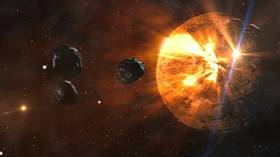Cutting it close: NASA just detected two asteroids headed towards the Earth… with two more right behind

NASA's Center for Near-Earth Object Studies (CNEOS) is currently monitoring a miniature swarm of four asteroids currently heading towards Earth, two of which were only detected on January 1.
CNEOS is tasked with watching the skies for any potentially hazardous asteroids, but given the vastness of space, that’s a lot of sky to check which may explain why two of the four asteroids were only spotted yesterday.
2020 AC, with a diameter of roughly 89 feet and traveling at approximately 13,000 miles per hour, will lead the charge, flying past the Earth at 1:56 am EST.
It will be followed soon after by the 72-foot-wide 2020AD, which is traveling at a blistering 35,000 miles per hour, and will buzz the earth at 4:12 am EST.
Also on rt.com Swing and a miss! Huge asteroid to narrowly pass by Earth on Boxing day2019 YH2, the largest in the group, measuring an estimated 459 feet in diameter and traveling at 32,000 miles per hour, is expected to pass by at 4:36 am EST.
Bringing up the rear will be 2019 AE3, measuring roughly 72 feet and traveling at over 18,000 miles per hour, will fly past us at 9:08 am EST.
2020 AD and 2019 YH2 are classified as Apollo asteroids, with very wide orbits, while 2020 AC and 2019 AE3 are Aten asteroids, meaning their semi-major axis is smaller than Earth's.
Also on rt.com Russia to track EARTH-THREATENING asteroids from robot-inhabited nuclear-powered polar Moon base2020 AD will come the closest to us, passing at a distance of just 556,000 miles (for reference, the moon is 238,855 miles away). 2019 YH2, on the other hand, will pass us at a distance of about 1.8 million miles. So thankfully 2020 won’t be kicking off with that big of a bang, but there is still cause for concern that we don’t know when the next asteroid might be coming right for us.
Like this story? Share it with a friend!














